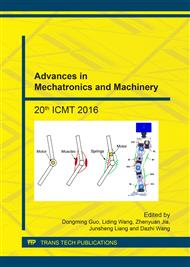[1]
I. Kato and H. Tsuiki, The Hydraulically Powered Biped Walking Machine with A High Carrying Capacity, IV Symp. on External Control of Human Extremities, (1972) 410-421.
Google Scholar
[2]
D. Förg, H. Ulbirch and A. Seyfarth, Study of a Bipedal Robot with Elastic Elements, 41st Int. Symp. on Robotics/6th German Conf. on Robotics, (2010) 689-695.
Google Scholar
[3]
K. Radkhah, T. Lens, A. Seyfarth and O. von Stryk, On the Influence of Elastic Actuation and Monoarticular Structures in Biologically Inspired Bipedal Robots, Proc. 2010 IEEE Int. Conf. on Biomedical Robotics and Biomechatronics, (2010) 389-394.
DOI: 10.1109/biorob.2010.5627797
Google Scholar
[4]
K. Radkhah, M. Maus, D. Scholz, A. Seyfarth and O. von Stryk, Towards Human-Like Bipedal Locomotion with Three-Segmented Elastic Legs, 41st Int. Symp. on Robotics / 6th German Conf. on Robotics, (2010) 696-703.
DOI: 10.1142/s0219843611002587
Google Scholar
[5]
G. Pratt and M. Williamson, Series Elastic Actuators, IEEE/RSJ Int. Conf. on Intelligent Robots and Systems, 1 (1995) 399-406.
DOI: 10.1109/iros.1995.525827
Google Scholar
[6]
F. Zajac, Muscle and Tendon Properties Models Scaling and Application to Biomechanics and Motor Control, Critical Reviews in Biomedical Engineering, 17 (1989) 359-410.
Google Scholar
[7]
S.L. Delp, J.P. Loan, M.G. Hoy, F.E. Zajac, E.L. Topp and J.M. Rosen, An Interactive Graphics-Based Model of the Lower Extremity to Study Orthopaedic Surgical Procedures, IEEE Trans. on Biomedical Engineering, 37 (1990) 757-767.
DOI: 10.1109/10.102791
Google Scholar
[8]
F.C. Anderson and M.G. Pandy, Dynamic Optimization of Human Walking, J. of Biomechanical Engineering, 123 (2001) 381-390.
DOI: 10.1115/1.1392310
Google Scholar
[9]
G.T. Yamaguchi and F.E. Zajac, A Planar Model of the Knee Joint to Characterize the Knee Extensor Mechanism, J. of Biomechanics, 22 (1989) 1-10.
DOI: 10.1016/0021-9290(89)90179-6
Google Scholar
[10]
H. A. Malki, D. Misir, D. Feigenspan and G. Chen, Fuzzy PID Control of a Flexible-Joint Robot Arm with Uncertainties from Time-Varying Loads, IEEE Trans. on Control Systems Technology, 5 (1997) 371-378.
DOI: 10.1109/87.572133
Google Scholar
[11]
S. Delp, F. Anderson, A. Arnold, P. Loan, A. Habib, C. John, E. Guendelman and D. Thelen, OpenSim: Open-source Software to Create and Analyze Dynamic Simulations of Movement. IEEE Trans. on Biomedical Engineering, 54 (2007) 1940–(1950).
DOI: 10.1109/tbme.2007.901024
Google Scholar
[12]
C.T. John, Complete Description of the Thelen 2003 Muscle Model, on http: /simtk-conuence. stanford. edu.
Google Scholar
[13]
R. Bortoletto, M. Sartori, F. He and E. Pagello, Simulating an Elastic Bipedal Robot Based on Musculoskeletal Modeling, Living Machines Conf. 2012, (2012) 26-37.
DOI: 10.1007/978-3-642-31525-1_3
Google Scholar
[14]
M. Sartori, D.G. Lloyd, M. Reggiani and E. Pagello, Fast Operation of Anatomical and Stiff Tendon Neuromuscular Models in EMG-Driven Modeling, 2010 IEEE Int. Conf. on Robotics and Automation (ICRA), (2010) 2228-2234.
DOI: 10.1109/robot.2010.5509932
Google Scholar
[15]
J.W. Sensinger and R.F. Weir, Improvements to Series Elastic Actuators, The 2nd IEEE/ASME Int. Conf. on Mechatronic and Embedded Systems and Applications, (2006) 1-7.
DOI: 10.1109/mesa.2006.296927
Google Scholar
[16]
D. Robinson, J. Pratt, D. Paluska and G. Pratt, Series Elastic Actuator Development for a Biomimetic Walking Robot, IEEE/ASME Int. Conf. on Advanced Intelligent Mechatronics, (1999) 561-568.
DOI: 10.1109/aim.1999.803231
Google Scholar
[17]
R. Van Ham, B. Vanderborght, M. Van Damme, B. Verrelst and D. Lefeber, MACCEPA, The Mechanically Adjustable Compliance and Controllable Equilibrium Position Actuator Design and Implementation in a Biped Robot, Robotics and Autonomous Systems, 55 (2007).
DOI: 10.1016/j.robot.2007.03.001
Google Scholar
[18]
M. Spong, Modeling and Control of Elastic Joint Robots, ASME J. of Dynamic Systems, Measurement and Control, 109 (1987) 310-319.
DOI: 10.1115/1.3143860
Google Scholar
[19]
B. Vanderborght, R. Van Ham, D. Lefeber, T. Sugar and K. Hollander Comparison of Mechanical Design and Energy Consumption of Adaptable, Passive-compliant Actuators, The Int. J. of Robotics Research, vol. 28 (2009) 90-103.
DOI: 10.1177/0278364908095333
Google Scholar
[20]
T. G. Sugar, K. W. Hollander and J. K. Hitt, Walking with Springs, The Int. Society for Optical Engineering (SPIE), 7976 (2011) 1-15.
Google Scholar


